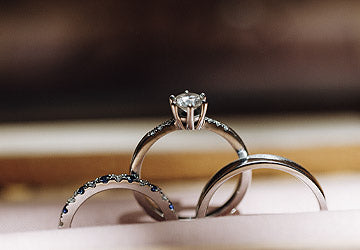Gold, Platinum and Silver
When finding the jewelry that speaks to your heart, supporting that decision with education is key. Not only do the properties of metals differ but they vary in maintenance requirements, wear and of course, price.
The process of determining the best metal for you is related to lifestyle and even allergies. Do you have a allergy to nickel? Do you regularly swim in a pool? Do you regularly work out? These are the types of questions that are pertinent in this process. While precious metals are beautiful, they all experience some wear over time and, unfortunately, it sometimes is takes breakage for something like metal corrosion to be apparent.
Let’s dive into some of the most basic information on gold, platinum and silver.
Gold
The popularity of gold continues to be unrivaled. And that’s for good reason. It is timeless, elegant and versatile. Because of it’s softness and malleability, it is mixed with other alloys such as zinc and copper. This not only adds needed strength but color. Those color variations include white, yellow and rose. For example, white gold is yellow gold that starts out as pure. A metal alloy is then added to make that gold creamy or white. Gold is also measured in karats. A karat of gold is a measurement of metal clarity (not to be confused with carat or unit of weight for a precious stone!).
While more scratch-resistant than a metal like platinum, gold does wear away. It is important to follow the recommended maintenance in order to preserve its color and ensure it’s longevity and protection. For white gold rings, a thin, protective layer of rhodium can be applied. This also makes it whiter and brighter. We recommend this and a light polish every six months.
Platinum
Platinum is a bright, white metal that is both rare and hypoallergenic. It is also more durable overall. Because it’s density is greater than gold, it lasts longer and doesn’t rub away. Like gold, Platinum is mixed with similar metals. However, it must be made up of minimum of 90% Platinum in order to be called that. Platinum alloys are thus considered more pure because they inherently are able to be used in a more pure form.
Abrasions to a Platinum piece will affect reflection and it begins to look dull over time. While Platinum does not tarnish or oxidize, it needs to be polished, and we recommend this every six months. Because of its whiteness and brightness, it is a perfect metal for pairing with diamonds or gems.
Silver
Silver has been popular for centuries. Because it comes in various shades of white and finishes, it is great metal in comparison and perfect for fashion jewelry. While silver is the most inexpensive option, the labor involved in silver metal jewelry design is one factor that drives the price as silver can be difficult to work with. Designer brands are also more expensive. Like the other metals, sterling silver is combined with other alloys to add strength. In order to be considered sterling silver, it needs to contain a minimum of 92.5% pure silver. Since silver tends to tarnish, proper care must be taken in preserving your silver jewelry. Typically, the best way to care for sterling silver jewelry is to polish it using a soft, non-abrasive cloth (preferably a silver polishing cloth). Also, be sure to avoid long periods of exposure to moisture and do not expose to chlorination.




